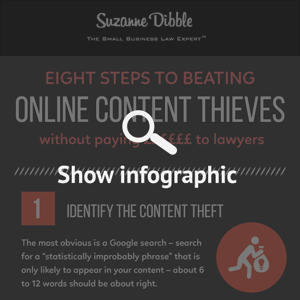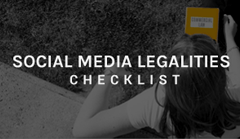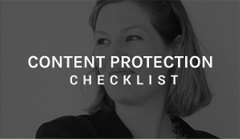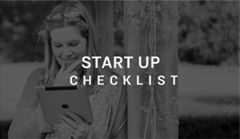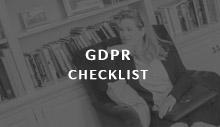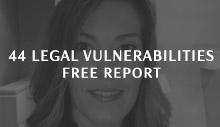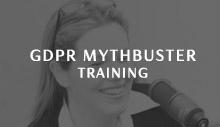
People copying your website content, your articles and your blog posts is really galling, especially when they are ranking higher in the search engines than you…
Follow these 7 simple steps to assert your rights to your content and make the “thief” take down your content.
Step one – identify the content theft
The most obvious is a Google search – search for a “statistically improbably phrase” that is only likely to appear in your content – about 6 to 12 words should be about right.
If you get a message similar to this one:
“In order to show you the most relevant results, we have omitted some entries very similar to the 1 already displayed. If you like, you can repeat the search with the omitted results included.”
then click the link and repeat the search. This means, quite literally, that other pages on the Web have content almost identical content to your own and you definitely need to follow up.
There are a number of other free tools that can help you identify any theft such as Copyscape, Plagium and, for images, TinEye or Google Images.
Step 2 – Gather evidence of theft
Take a screenshot of the offending content clearly showing the url on which it is published and save it which will provide evidence of the date you viewed it.
Step 3 – gather evidence of your ownership
Check through your files and identify all drafts and versions of the content so that you can show the date on which you created it.
You can also compare the source codes of the offending site with your site and take evidence of exactly how much of your content, including your code, was stolen.
Check that you actually own the copyright – laws on this differ around the world but in the UK, copyright arises automatically on the creation of an original work and is owned by the creator. You don't need to register it to benefit from copyright protection although it may help you establish ownership. If the work was commissioned from a third party, they will own the copyright (even if you paid them) so you need to check that copyright has passed to you by way of an appropriate assignment.
Finally, check that the “thief” hasn't legally used your work under a fair dealing or fair use exception or similar.
Step 4 – email the thief
With a little detective work, you can usually find some contact information about the thief. As well as the obvious About and Contact Us pages, you might want to check the footer notes and the meta tags.
Once you have a contact name, address, or email, you can find out more on WHOIS, Alexa or just by googling them.
When you email the thief you should remain professional at all times and (i) inform them of the theft, (ii) assert your right to copyright ownership, (iii) request the removal, correction or modification of the content and/or compensation, (iv) ask for a response within 5 days from the date of your email and (v) explain that you are willing to take this further by contacting their advertisers to inform them of the infringement, contacting their hosting company to request take down of the content or disabling of the website and issuing proceedings against them. An example email is in the Checklist referred to at the end of this article.
Step 5 – send a Cease and Desist Letter
A Cease and Desist Letter is just a formal letter that says “Stop or Else” and shows that you are serious. Give them 24 to 36 hours to respond.
The Cease and Desist Letter will include some or all of the following:
- Description of the copyright infringement and the theft of intellectual property.
- A requirement that they cease and desist from infringing your copyright.
- A clear timetable for response.
- A requirement to remove or destroy the page with the stolen content.
- An assertion that they will be liable for any and all solicitor's fees, court costs, and damages.
- Your intention to send copies of this Cease and Desist Letter to their ISP, hosting company and advertisers to let them know of the infringement.
- A clear statement that you will take further legal action if this is not resolved to your satisfaction by the deadline.
- A demand for a payment of all profits and income derived from use of the infringing content.
- A demand for compensation for any and all profits and income that you have lost due to the copyright theft.
- A demand for compensation for any lost profits, income, and reputation.
- A clear statement about how they are to respond to you eg by phone, email, in writing (mail), and if they are to respond directly to you or to your lawyer.
Step 6 – contact advertisers
Another bit of leverage you have is to contact the businesses advertising on the offending website.
If you don't receive a reply to your Cease and Desist Letter, send the advertisers a letter or email outlining the specific copyright violations and copies of your requests to stop and the Cease and Desist letter.
This is normally enough for the advertisers to pull their adverts from the offending site.
Step 7 – issue a Take Down notice
According to EU law, hosting companies are not liable for infringing information, provided that they have no actual knowledge of any illegal activity, and that on obtaining such knowledge they act “expeditiously” to remove or disable access to the information.
So if you issue a Take Down Notice to the hosting company, they will have actual knowledge of an illegal activity and are bound to take steps to remove or disable access to the information.
Step 8 – file a DMCA complaint with Google
A DMCA (Digital Millennium Copyright Act) complaint with Google won't physically remove the stolen pieces from the server but will de-index them from Google, so as a result they won't be getting a lot of traffic and certainly won't rank higher than your originals.
So there you have it – hopefully if you follow these steps, you will at the very least have succeeded in the infringing content being taken down from the web and may even have recovered some compensation. If you are struggling, consult a lawyer to determine your options going forwards.
If you want to grab a copy of your Copyright Protection Checklist that will help you to follow these steps and provide a plan to protect your online content, click here.
If you want to get hold of all of the documents mentioned in this article and 60 or so more, then check out our online Legal Academy that provides a very cost effective way to protect your business against all common legal issues.
Disclaimer
Although the concepts in this article have global application, the information contained in the article is based on English law only and is provided for information purposes only and is not intended to amount to advice on which reliance should be placed. Suzanne disclaims all liability and responsibility arising from any reliance placed on such information. Professional advice should be obtained before taking or refraining from taking any action as a result of the above contents.

